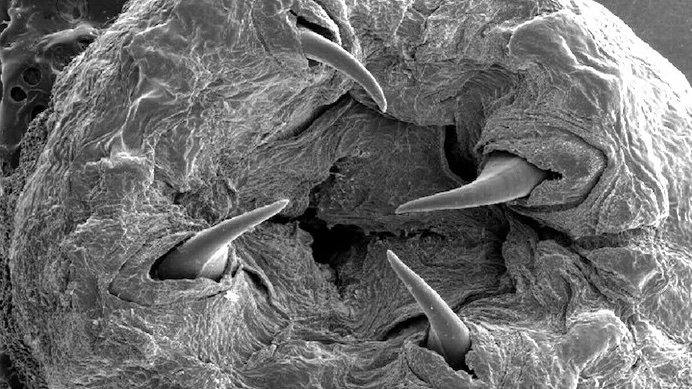Venomous bloodworms grow deadly copper fangs with totally metal trick
The worms have the highest copper concentrations of any animal.

A venomous bloodworm species grows bizarre, deadly metal teeth, and now scientists know how: with a single, simple protein that transforms copper deposits located at the bottom of the seafloor into fearsome fangs.
Bloodworms (Glycera dibranchiata) are segmented, bright-red marine worms that can grow to be 14 inches (35 centimeters) long and have 0.08-inch-long (2-millimeters) needle-like teeth made from a mixture of protein, melanin and 10% copper, the highest concentration in any animal.
Bloodworms live in shallow tidal flats and hunt by burrowing into sand and ambushing anything they are able to swallow. When a bloodworm is close enough to strike, it inverts its digestive system — which includes its teeth — launching its guts out of its body like a torpedo at its target. Upon contact, the worm's jaw clamps shut and injects its victim with a deadly venom that contains 32 different types of toxins, paralyzing the prey in preparation for being eaten alive.
Related: Why don't poisonous animals die from their own toxins?
"These are very disagreeable worms in that they are ill-tempered and easily provoked," study co-author Herbert Waite, a biochemist at University of California, Santa Barbara said in a statement. "When they encounter another worm, they usually fight using their copper jaws as weapons."
To grow these copper-toothed stomach jaws, which last through the worms’ entire five-year lifespan, bloodworms harvest the metal from marine sediments on the seafloor. Then, through a previously unknown chemical reaction, the worms fuse the copper to their jaws.
This teeth-forming chemical process had never been documented before. But the new study, published Monday (April 25) in the journal Matter, has uncovered the chemical basis for the unusual adaptation.
Sign up for the Live Science daily newsletter now
Get the world’s most fascinating discoveries delivered straight to your inbox.
The bloodworms begin this process by producing an amino acid called dihydroxyphenylalanine (DOPA) and using it to gather up seafloor copper into a thick, protein-rich liquid that exists in a separate phase from ocean water. Then, by using the copper as a catalyst, the worm transforms DOPA into melanin, a polymer that can be combined with copper to create the four needle-like teeth inside a bloodworm’s jaw.
The researchers say that this natural process enables the worms to easily synthesize a material that would usually require a great deal of effort to make in a lab. "We never expected protein with such a simple composition, that is, mostly glycine and histidine, to perform this many functions and unrelated activities," Waite said.
Now that the study authors have discovered how the bloodthirsty beasties go about fashioning their gruesome hunting tools, the researchers say that further investigations could delve deeper into the chemical process, and possibly provide some vital hints into how it could be used by humans to make new composite materials.
"These materials could be road signs for how to make and engineer better consumer materials," Waite said.
Originally published on Live Science.

Ben Turner is a U.K. based staff writer at Live Science. He covers physics and astronomy, among other topics like tech and climate change. He graduated from University College London with a degree in particle physics before training as a journalist. When he's not writing, Ben enjoys reading literature, playing the guitar and embarrassing himself with chess.










